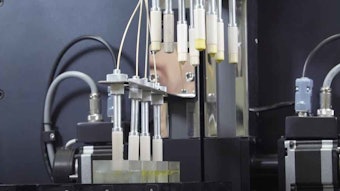Recent work conducted at the Kyoto University Institute for Integrated Cell-Material Sciences (iCeMS) on nano-sized polymer assemblies was published in the Oct. 5, 2010, edition of Nature Communications. The research paper, "Unveiling Polymer Thermal Transitions in Subnanometre Pores," was co-authored by Takashi Uemura, Nobuhiro Yanai, Satoshi Watanabe, Hideki Tanaka, Ryohei Numaguchi, Minoru T. Miyahara, Yusuke Ohta, Masataka Nagaoka and Susumu Kitagawa.
According to a university report, knowing how to build nano-sized assemblies of polymers could improve a broad range of processes, from the production of nanofibers, filters and new materials to the manufacture of low-energy, nanoscale circuits and devices. This work is said to shed light on the behavior of polymers in specially engineered confined spaces. The researchers successfully manufactured sub-nanometer scale channels or pores that can be manipulated to trap polymers. These allow the researchers to observe how polymer chains respond to temperature changes. This level of observation was reportedly not possible previously.
The technique uses porous coordination polymers (PCPs), which are said to be notable for the high degree to which their pore sizes and other characteristics can be controlled. "PCPs allow us to design cages in which to trap specific molecules," said lead scientist Uemura, in the university press release. "In this case, polyethylene glycol molecules (PEGs) [were] accommodated in the cages similarly to the way in which sea eels hide in holes. In open water, there is no order to their swimming. But in cylindrical pipes, they prefer to arrange themselves linearly in groups. Polymer chains do this as well, becoming orderly assembled in the PCP channels."
The PCP channels were tuned to control their size and inner surface characteristics, allowing the researchers to observe how the polymers behaved. This led to the unexpected finding that the transition temperature—in this case, the melting point—of confined PEGs decreased as their molecular weight—length, in this instance—increased. According to co-author and iCeMS deputy director Kitagawa, this was exactly the opposite of what had been observed in bulk. "We believe this to be the result of destabilization of the PEG chains under confinement. Instability increases together with chain length," explained Kitagawa, in the press release.
Nanotechnology has been a recent topic of debate among cosmetics R&D researchers as their level of delivery and penetration, if any, has raised alarm within some groups. In general, it has been found that such materials do not penetrate the stratum corneum beyond a surface level. Work in this area is ongoing, and this new approach to studying the effects of nano-sized assemblies of polymers could further this work, as well as implicate their use in new applications.
In related work, for instance, as previously reported, during the International Federation of the Societies of Cosmetic Chemists (IFSCC) Conference held in 2009, Robert Lochhead, PhD (University of Southern Mississippi) described an investigation into whether macromolecules could be designed to fit into intercellular spaces and de concluded that under the right conditions, they could. After his presentation, one attendee asked whether these materials could be applied in antiaging applications. “Can you use the polymers, [for example], to fit into the spaces of skin, to remove wrinkles?” While Lochhead replied, “I’m just the chemist. The rest is up to you guys,” attendees of the event found this to be an interesting concept.










